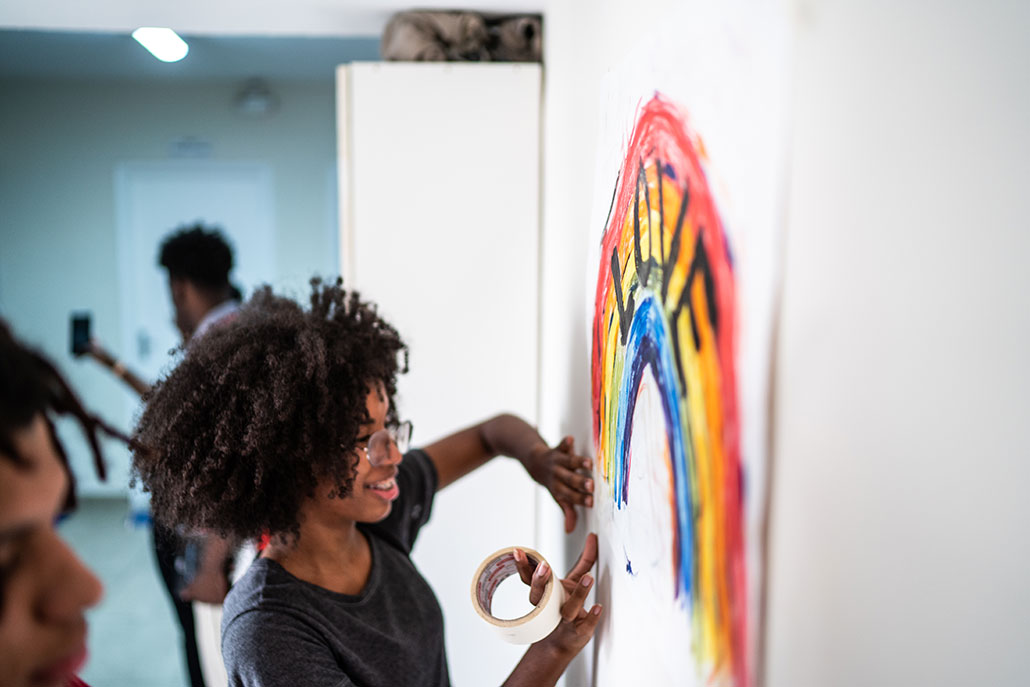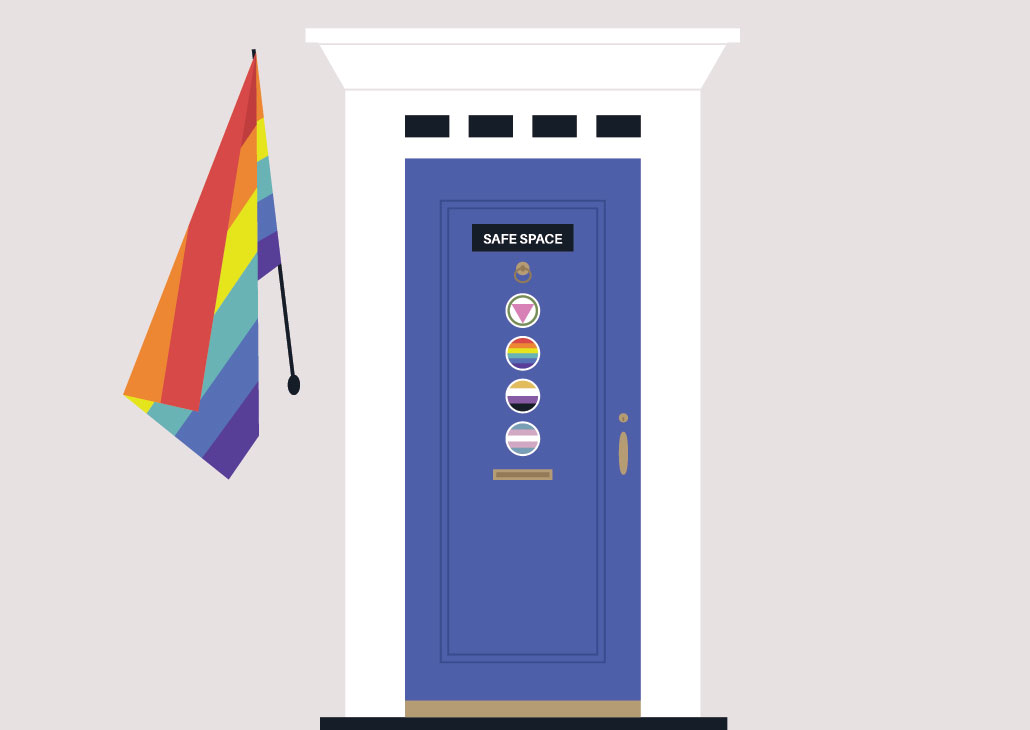Supportive spaces help LGBTQ+ youth thrive in school and beyond
Student-led advocacy groups in school improve mental health among young people

Student clubs called GSAs offer safe spaces for LGBTQ+ youth to socialize and work. These can improve schools and communities for all students.
DisobeyArt/istock/Getty Images Plus
Share this:
- Share via email (Opens in new window) Email
- Click to share on Facebook (Opens in new window) Facebook
- Click to share on X (Opens in new window) X
- Click to share on Pinterest (Opens in new window) Pinterest
- Click to share on Reddit (Opens in new window) Reddit
- Share to Google Classroom (Opens in new window) Google Classroom
- Click to print (Opens in new window) Print
By Laura Allen
It’s a hard time to be a teenager. General rates of sadness among young people are at an all-time high. But they’re especially high for students who identify as LGBTQ+.
The initials stand for lesbian, gay, bisexual, transgender and queer or questioning. (The “+” sign includes people with sexual or gender identities that don’t fall in those categories.) An estimated 2 million LGBTQ+ teens (ages 13-17) live in the United States. And they often feel more sad and unwelcome at school than their non-LGBTQ+ peers.
One 2021 survey, for instance, found nearly seven in every 10 LGBTQ+ teens had felt so sad and hopeless in the past year that they stopped doing their usual activities. This was the highest level of sadness reported among groups based on race, sex and sexual identity.
The reason so many LGBTQ+ students suffer from depression and do worse than other students in school is not because of their gender or sexuality. It stems from something called minority stress, says Sarah Kiperman. She’s a school psychologist who works at Wayne State University in Detroit, Mich.
LGBTQ+ kids are more likely to face discrimination based on their gender or sexuality than other young people. When people face discrimination because of their identity, it creates stress. This extra stress can cause anxiety and depression and reduce academic success.
But it doesn’t have to be this way. Research has identified several strategies that can improve wellness in LGBTQ+ kids. Family acceptance promotes positive self-esteem and leads to better health for these youth. Student-led clubs and advocacy efforts also have been shown to improve mental health in LGBTQ+ students. Staff training and anti-bullying policies, too, can help these students feel safer at school. Together, these things can improve students’ grades and reduce their risk of depression or suicide.
Student-led advocacy
“Schools that are welcoming and affirming enable youth to thrive,” says Paul Poteat. He works at Boston College in Massachusetts. A psychologist, he studies the school experiences of LGBTQ+ students. And he’s seen how they suffer higher rates of depression than their heterosexual and cisgender peers. (Cisgender refers to people who identify as the same gender they were assigned at birth.) LGBTQ+ youth experience more harassment and bullying as well.
Poteat’s team wanted to understand what might improve school experiences for these kids. The researchers focused on something that already exists in many schools: a club called a GSA. This stands for Gender and Sexuality Alliance. Nearly four in every 10 U.S. high schools have them.
GSAs are student-led. Their members and activities may change year to year. They usually have a social component — and often a political one, says teacher Marty Wilder. He used to be an adult facilitator for a GSA at a high school in Eugene, Ore.
The one at Wilder’s school was a safe place for the students to socialize. Members planned events, such as dances. They also organized protests. They made the LGBTQ+ experience visible to the student body and worked to change school policies in ways that made them more supportive and inclusive of LGBTQ+ students. When the GSA asked that sex education include LGBTQ+ experiences, for instance, the sex-ed teacher invited club members to teach it. And they did.
Some GSA actions, such as social events, focus mainly on club members. Others might target broader changes, such as getting a school to offer all-gender restrooms for students who are not comfortable using a “boys” or “girls” room. Or making sure school anti-bullying policies include rules against harassing someone based on their gender and sexuality.
Past research has showed that LGBTQ+ students do slightly better in schools with a GSA than in those without one. They feel more welcome, for instance. They also get better grades. But researchers didn’t know what precisely about GSAs led to the difference. Poteat’s team wondered if school-wide advocacy efforts played a part.
To find out, these researchers surveyed students at 23 Massachusetts schools that have a GSA. Some were urban, others rural. Some were big, others small. Of the surveyed students, 245 were in their school’s GSA. Another 1,362 were not. The students came from different racial backgrounds and were both straight and queer.
GSA members reported what activities their club did. The researchers also asked all students about their experiences in school and their mental health over the course of a year. “We wanted to see if students showed an improvement in mental health at the end of the year,” explains Poteat. Those mental-health outcomes might then be linked to specific GSA activities over that year.

Where a GSA did school-wide advocacy, the mental health of all students at that school tended to improve, the data showed. LGBTQ+ students benefited the most. Poteat thinks this may be because the GSAs worked on issues affecting those students. And fostering a more accepting atmosphere at school may have helped other students too.
The researchers published their results in the Journal of Clinical Child and Adolescent Psychology on February 20.
Supportive environments
It’s helpful to know how GSAs can benefit the LGBTQ+ community, Poteat says. But it wouldn’t be fair to place all responsibility on their student-led programs. Supporting these students should be a school-wide effort — one that includes administrators, teachers and other adults.
For example, schools should have anti-bullying policies that address gender and sexuality, says Jessica Fish. And staff should be trained on how to address bullying that targets LGBTQ+ kids. Fish is a scientist who focuses on human development and family at the University of Maryland in College Park.
One 2022 study suggests that staff training on gender and sexuality issues can lead to long-lasting improvements in the school experience for LGBTQ+ kids. In that study, researchers looked at how California high-school students rated their school’s climate in the years 2004 and 2014. Students rated factors such as their sense of safety and school connectedness. Some schools trained their staff on issues around gender and sexuality in 2004, 2014 or both years. Those trained in 2004 or both years tended to have more positive climates than schools with training only in 2014.
A 2021 national survey of more than 22,000 students also showed that schools with supportive policies and staff feel safer and more welcoming to young queer people.
Adult role models can help, too. When Wilder was a new teacher, he didn’t disclose his transgender identity to everyone. He shared it only within the GSA. One day, a student asked the queer teachers who weren’t open about their identity: “What message does that give the queer youth?” Before, Wilder thought his identity as a trans man didn’t matter to his teaching of math or engineering. Then, he realized he could be open with all students, especially transphobic ones. Doing so, he realized, might make the school a safer place for queer kids, too.
Beyond cultivating a supportive environment, schools can help LGBTQ+ students take care of their mental health. Fish worked with LGBTQ+ youth from a community center in Texas to develop a school program called Be You! This training taught teens skills to cope with stress and improve their mental health.
More than 50 students in nine Texas schools participated during the 2017-2018 school year. Fish’s team surveyed them before and after this experience and found that participants had learned to better manage stress. After this training, they also reported spending less time dwelling on negative feelings. The team shared these outcomes last December in the Journal of Gay and Lesbian Social Services.
Friends and family
Schools have a huge impact on the mental health of their students. But home life matters deeply, too. Support and acceptance from parents greatly improve wellness in LGBTQ+ kids, Kiperman says.
Teens who want to provide their parents with resources on the LGBTQ+ community can start online. Groups like PFLAG or The Trevor Project have many resources. PFLAG, a group for parents and friends of LGBTQ+ people, has local chapters around the country. And The Gender Spectrum has resources and online groups for caregivers or parents of trans and nonbinary youth.
Teens with LGBTQ+ friends can be allies, too. In past research, Kiperman asked LGBTQ+ youth what they need to feel supported. One thing they mentioned was emotional support — feeling valued, loved and able to get a hug when they needed one. Everyone needs emotional support. But LGBTQ+ people may need more to counteract the discrimination they face, Kiperman says.
In a recent report, LGBTQ+ young people also noted they would like people in their lives to know more about topics connected to their identity, such as how to properly use pronouns and create safe spaces.

LGBTQ+ teens who don’t have supportive school or home environments may find communities online. One option is TrevorSpace, an online community for queer people 13 to 24 years old to explore their identity, seek advice and meet people.
Communities of queer people online and in-person, supportive family and friends and schools all have important roles to play in making LGBTQ+ teens feel happier and more accepted. What would a world look like where all LGBTQ+ people are accepted? In the words of more than 28,000 young queer people surveyed by the Trevor Project this year, here is that world: Peaceful. Better. Happy. Normal. Beautiful. Safe.
And we can work together to make it so.
@trevorproject Join us on TrevorSpace, our international social media site for LGBTQ young people!🌈🧡🙌 #lgbtqtiktok #thetrevorproject #trevorspace #lgbtq🌈 #lesbianvisibiltyday
♬ I Can Feel It v3 – Nick Sena and Danny Echevarria
Resources guide
GLSEN works to make schools more inclusive and supportive. Your school can access resources for teachers, GSAs and district policies.
Want to start a GSA at your school? The GSA Network supports and trains youth leaders and supports new and existing GSAs nationwide.
Feeling sad or need someone to talk to? The Trevor Project is available day or night to support youth feeling lonely or thinking about suicide. Chat, text or voice call confidentially. This group also has resources and an online community space.
Visit TrevorSpace, an online community for queer youth (13-24 years), to explore identity, get advice, find support and make friends.
The video series “PS. LGBTQ+ Youth Matter” provides resources on coming out, mental health and more. Sarah Kiperman’s team designed the program with LBGTQ+ kids at a community center in Atlanta, Ga.
PFLAG supports LGBTQ+ people and those who love them. Visit the PFLAG website for resources and to find a local chapter.
The Gender Spectrum supports transgender and nonbinary youth through resources and events. They host online groups for kids, teens, parents, caregivers and other family members.
For faith-based needs, the Institute for Welcoming Resources lists LGBTQ+-friendly congregations, plus resources to help churches to be more inclusive. Find more faith-based resources at the Family Acceptance Project® and at Parity.
Suicide was the third leading cause of death among U.S. teens ages 15-19 in 2021. If you or someone you know is suffering from suicidal thoughts, please seek help. In the United States, you can reach the Suicide Crisis Lifeline by calling or texting 988. Please do not suffer in silence.






